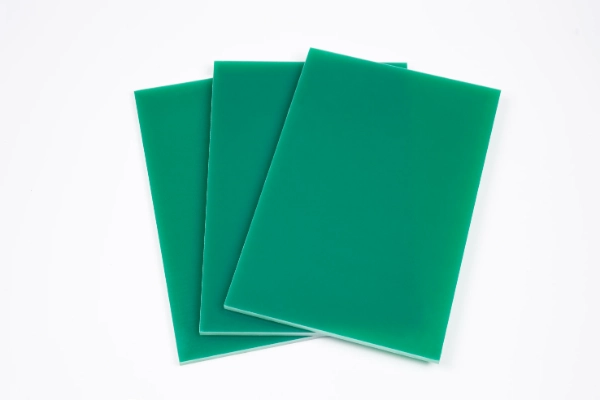- This topic is empty.
-
AuthorPosts
-
29/04/2025 at 14:46 #95073
The automotive industry is continuously evolving with increasing demands for safety, performance, durability, and sustainability. Among the numerous materials supporting this evolution, high-performance composite laminates have gained significant prominence. One such material is FR5 epoxy resin laminate, a specialized grade of composite that offers exceptional thermal and mechanical stability. In this blog post, as a high performance epoxy fiberglass laminate exporter, Blue Sun will share the applications of FR5 epoxy resin laminate in automotive field, including its properties, advantages, etc.
Overview of FR5 Epoxy Resin Laminate
FR5 is a high-grade, glass-reinforced epoxy laminate that conforms to the NEMA (National Electrical Manufacturers Association) standard. It is an upgraded version of the commonly used FR4 laminate, distinguished by its superior thermal endurance. FR5 is manufactured by impregnating woven glass cloth with an epoxy resin binder under high temperature and pressure. The resulting material exhibits high dielectric strength, thermal stability, and mechanical integrity, even in harsh environments.
Key Properties of FR5 Epoxy Resin Laminate
– High Thermal Resistance: Glass transition temperature (Tg) > 150°C.
– Excellent Electrical Insulation: Dielectric strength often exceeds 500 V/mil.
– Dimensional Stability: Maintains structural integrity under high mechanical stress and thermal cycling.
– Moisture Resistance: Low water absorption ensures reliable performance in humid conditions.
– Flame Retardance: Classified as UL 94 V-0, meeting stringent flammability standards.

Applications of FR5 Epoxy Resin Laminate in Automotive Industry
The demand for thermally stable and electrically insulating materials in modern vehicles, particularly electric and hybrid models, has brought FR5 epoxy resin laminate into focus. Below are the primary areas of its application:
1. Electric and Hybrid Vehicle (EV/HEV) Power Electronics
Power electronics are at the heart of EVs and HEVs, managing energy flow between the battery, inverter, electric motor, and auxiliary systems. The insulation and thermal management of power modules are crucial for system reliability and efficiency.
FR5' s Contribution:
– Insulation Substrates: Used as base plates for printed circuit boards (PCBs) in power inverters, where high voltage insulation is mandatory.
– Thermal Isolation: Offers excellent heat resistance for supporting semiconductor packaging, reducing the risk of thermal degradation.
– Durability: Withstands thermal cycling caused by high switching frequencies and power surges.
2. Battery Management Systems (BMS)
BMS modules are critical for monitoring and controlling battery parameters such as temperature, voltage, and current. These systems require high-reliability PCBs and enclosures, especially in high-voltage configurations.
FR5' s Contribution:
– PCB Base Material: Serves as the foundation for multilayer BMS circuit boards, ensuring long-term electrical insulation.
– Safety Enhancements: Flame-retardant characteristics improve fire safety, particularly in the event of thermal runaway scenarios.
– Environmental Resistance: High mechanical strength and low moisture absorption improve performance across diverse climatic conditions.
3. Electric Motor Components
Electric motors used in EVs, particularly traction motors, operate under demanding conditions with exposure to heat, vibration, and electromagnetic fields. Insulating and mechanically supportive materials are required to ensure operational integrity.
FR5' s Contribution:
– Slot Liners and Phase Insulators: Employed as dielectric barriers between motor windings to prevent electrical shorts.
– Rotor and Stator End Insulation: Provides support and insulation to prevent arc tracking and improve reliability.
– Thermal Barrier Layers: Maintains performance during motor overheating or excessive load conditions.
4. ADAS and Vehicle Control Systems
Advanced Driver-Assistance Systems (ADAS) and vehicle control modules are heavily reliant on high-performance electronics. FR5 is often utilized in these high-reliability systems, particularly for components close to heat sources or exposed to dynamic environmental stresses.
FR5' s Contribution:
– Sensor Boards and Controllers: Ideal for camera modules, radar processors, and braking system controllers that operate in thermally active zones.
– Long-Term Reliability: Enhanced resistance to thermal fatigue and dielectric breakdown ensures functional safety over the vehicle' s lifespan.
5. Lighting Systems
With the evolution of LED-based lighting, vehicle headlamps, DRLs, and interior lighting units require effective thermal and electrical management to sustain efficiency and longevity.
FR5' s Contribution:
– Heat Dissipation: Serves as a structural support and thermal management layer behind LED arrays.
– Electrical Isolation: Prevents leakage currents and supports high-power LED configurations with minimal dielectric loss.
Advantages of FR5 Epoxy Resin Laminate in Automotive Applications
– Superior Thermal Endurance: Essential for modern vehicles with compact, high-density electronic layouts.
– Improved System Safety: Flame retardance and high dielectric strength reduce the risk of electrical fires and arcing.
– Longevity and Reliability: Performs consistently over prolonged exposure to harsh automotive environments.
– Design Flexibility: Compatible with multilayer PCB constructions, enabling complex and miniaturized circuitry.
Processing and Integration Considerations
While FR5 offers impressive advantages, certain considerations must be addressed during its integration into automotive systems:
– Machinability: Requires specialized tools for precision cutting and drilling due to its hardness and fiberglass content.
– Cost Factors: Higher cost compared to FR4 may limit its use to critical components unless economies of scale are achieved.
– Thermal Interface Compatibility: Should be paired with effective thermal interface materials (TIMs) to ensure optimal heat dissipation.
– Regulatory Compliance: Must meet automotive standards such as ISO 16750, IEC 60664, and AEC-Q200 depending on application scope.
Conclusion
The application of FR5 epoxy resin laminate in the automotive field signifies a vital advancement in material engineering, particularly in the realm of electric mobility and intelligent systems. Its blend of thermal resilience, electrical insulation, and mechanical strength make it a go-to solution for critical vehicle subsystems. As automotive technologies become increasingly electrified and compact, materials like FR5 will play an even greater role in shaping the next generation of reliable, high-performance vehicles.
http://www.bluesun-elec.com.cn
Blue Sun -
AuthorPosts
- You must be logged in to reply to this topic.
